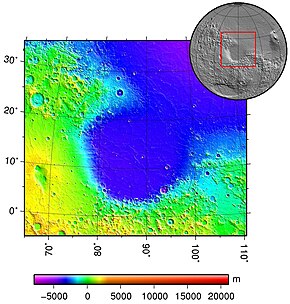 Topography of Isidis Planitia | |
| Location | North of Hellas Planitia, east of Syrtis Major Planum, Mars |
|---|---|
| Coordinates | 12°54′N 87°00′E / 12.9°N 87.0°E |
| Diameter | 1,900 km (1,200 mi)[1] |
| Eponym | Isis is the Egyptian goddess of heaven and fertility. |
Isidis Planitia is a plain located within a giant impact basin on Mars, located partly in the Syrtis Major quadrangle and partly in the Amenthes quadrangle. At approximately 1,900 km (1,200 mi) in diameter,[1] it is the third-largest confirmed impact structure on the planet, after the Hellas and Utopia basins. Isidis was likely the last major basin to be formed on Mars, having formed approximately 3.9 billion years ago during the Noachian period.[2] Due to dust coverage, it typically appears bright in telescopic views, and was mapped as a classical albedo feature, Isidis Regio, visible by telescope in the pre-spacecraft era.
A study reported in Icarus described the complex geologic history of parts of Isidis, especially areas near the Deuteronilus contact. This contact is the supposed edge of a vast Martian ocean. The researchers found evidence of a Late Hesperian/Early Amazonian Sea in the area. The sea would have quickly frozen over. Eskers formed under the ice.[3]
Just to the west of Isidis is Syrtis Major Planum, a low-relief shield volcano that is a prominent dark albedo feature of Mars, which formed after the basin.[4] The westernmost extent is bounded by a subregion, Northeast Syrtis with diverse geology. Around the Isidis basin magnesium carbonate was found by the Mars Reconnaissance Orbiter. This mineral indicates that water was present and that it was not acidic, pH conditions more favorable for the evolution of life.[5]
The name Isidis Planitia follows the earlier name Isidis Regio ('region of Isis'). Isis is the Egyptian goddess of heaven and fertility.
- ^ a b Cite error: The named reference
Tornabene2008was invoked but never defined (see the help page). - ^ Ritzer, J.; Hauck, S. (June 2009), "Lithospheric structure and tectonics at Isidis Planitia, Mars", Icarus, 201 (2): 528–539, Bibcode:2009Icar..201..528R, doi:10.1016/j.icarus.2009.01.025
- ^ Erkeling, G.; Reiss, D.; Hiesinger, H.; Ivanov, M.A.; Hauber, E.; Bernhardt, H. (November 2014). "Landscape formation at the Deuteronilus contact in southern Isidis Planitia, Mars: Implications for an Isidis Sea?" (PDF). Icarus. 242: 329–351. Bibcode:2014Icar..242..329E. doi:10.1016/j.icarus.2014.08.015.
- ^ Hiesinger, H.; Head, J. W. (2004-01-08), "The Syrtis Major volcanic province, Mars: Synthesis from Mars Global Surveyor data", Journal of Geophysical Research: Planets, 109 (E1): E01004, Bibcode:2004JGRE..109.1004H, doi:10.1029/2003JE002143, E01004
- ^ Murchie, S. L.; Mustard, J. F.; Ehlmann, B. L.; Milliken, R. E.; Bishop, J. L.; McKeown, N. K.; Noe Dobrea, E. Z.; Seelos, F. P.; Buczkowski, D. L.; Wiseman, S. M.; Arvidson, R. E.; Wray, J. J.; Swayze, G.; Clark, R. N.; Des Marais, D. J.; McEwen, A. S.; Bibring, J.-P. (February 2009). "A synthesis of Martian aqueous mineralogy after 1 Mars year of observations from the Mars Reconnaissance Orbiter" (PDF). Journal of Geophysical Research: Planets. 114 (E2): E00D06. Bibcode:2009JGRE..114.0D06M. doi:10.1029/2009JE003342. ISSN 0148-0227.